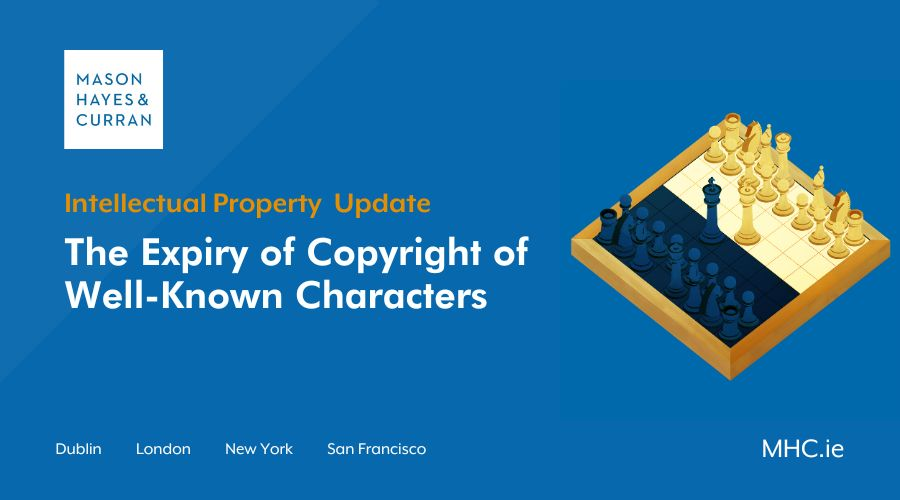The Expiry of Copyright of Well-Known Characters
A Batman Logo Related Discussion

The EU General Court recently confirmed that the Batman insignia can avail of copyright and trade mark protection. This will ensure the continued protection of the Batman logo for certain goods and services when the copyright expires. Gerard Kelly, Head of Intellectual Property, looks at the interplay between copyright and trade mark protection. He also considers the future for famous characters as they fall out of copyright, which has now become an IP protection concern for a variety of well-known characters.
In the aftermath of the release of a horror movie featuring a version of Winnie the Pooh that has fallen into the public domain, there has been much discussion around the future of famous characters whose term of copyright is about to run out. As the end of term of copyright approaches for many famous characters, we examine the requirements for both copyright and trade mark protection, and the potential benefits of dual protection for certain insignia.
Dual protection under trade mark law and copyright protection
In the Batman insignia case[1], which concerned the below Batman logo, the EU General Court dismissed the applicant’s various claims that a mark may not enjoy trade mark protection because the Batman insignia is protected as a literary and artistic work under copyright law.

A similar issue arose in the Dr. No/Dr. NO case[2], involving the famous James Bond character, dismissing the applicant’s contention that Dr No indicates artistic origin rather than commercial origin. The court noted in the Dr. No case that:
“The same sign may be protected as an original creative work by copyright and as an indicator of commercial origin by trade mark law. It is therefore a matter of different exclusive rights based on distinct qualities, that is to say the original nature of a creation, on the one hand, and the ability of a sign to distinguish the commercial origin of the goods and services, on the other……Therefore, even if the title of a film can be protected pursuant to certain national laws as an artistic creation independent of the film itself, it cannot automatically enjoy the protection afforded to indicators of commercial origin, since only signs which develop characteristic trade mark functions may enjoy that protection.[3]”
There are distinct requirements to benefit from trade mark and copyright protection. Copyright which protects the expression of an idea, arises automatically in Ireland. In such circumstances, there is a requirement that the work be original in that the work is the author’s own intellectual creation and cannot be a copy of another work.
Trade marks are used as a means of distinguishing goods and services belonging to businesses. To avail of trade mark protection the trade mark must be capable of:
- Being a sign
- Distinguishing the goods or services of one undertaking from those of other undertakings, and
- Being represented on the register in a manner which enables the competent authorities and the public to determine the clear and precise subject matter of the protection afforded to its proprietor
It follows that if a mark lacks distinctive character, registration will be refused.
As a consequence of this difference between both intellectual property rights the fact that an image might be protected by copyright does not automatically mean it will be protected by trade mark law. For example, the fact that the shape of a bag might be protected by copyright or be registered as a design right does not mean that the bag has the level of distinctiveness necessary for it to be eligible for registration as a trade mark. Conversely, both intellectual property rights can and are exploited.
Trade mark registration forever
In addition to different requirements to obtain protection under copyright law and trade mark law, the term of protection differs. In Europe copyright in a literary, dramatic, musical or artistic work expires 70 years after the death of the author[4]. Critically, integrity[5] or moral rights those being a right of an author to object to a distortion, mutilation etc; of works, also concludes on the expiry of the economic right. Trade marks are registered for a ten-year period and may be renewed indefinitely.
The Batman logo case
In the Batman logo case the EU General Court examined the claimants’:
- Insufficient knowledge claim
- Claim that the Batman insignia is devoid of distinctive character, and
- Claim that the Batman insignia is descriptive of goods
The claimants, who sought to invalidate the Batman trade mark, argued that they were unable to determine the reason for the contested decision on the basis that the statement of reasons supplied by the Board fell foul of Article 94(1) of Regulation 2017/1001 and Article 41(2) Charter of Fundamental Rights of the EU. Essentially these provisions exist so that parties know the justification for measures taken to enable them to defend their case. The court noted that the Board is not required to provide an exhaustive explanation. The court concluded that there was sufficient knowledge of the reasons based on the paragraphs provided in the decision.
The claimants also submitted that the Batman mark is not perceived as an indication of origin which is one of the essential hallmarks of a trade mark, instead it is a symbol “referring to the Batman character and an ornamental element of those goods”. Referring to Article 7(1)(b) of the Trade Mark Regulation[6], the court confirmed that trade marks that are devoid of distinctive character shall not be registered.
The relevant date for assessing distinctiveness is the date of filing. In terms of evidence the Court noted that the applicant had not supplied any evidence of probative value, such as survey evidence, with regard to the relevant public’s knowledge and perception of the contested mark at the date of filing. Much of the evidence was dismissed including Wikipedia references which can be easily altered. Further the court did not find the absence of reference to DC comics on book covers, DC is only referenced on 16 of 134 comics, makes it possible to establish the public’s perception regarding the trade mark’s commercial origin.
The court also dismissed the applicant’s contention that a mark may not enjoy trade mark protection because the Batman insignia is protected as a literary and artistic work under copyright.
One of the applicant’s arguments was that the sign described one of the characteristics of the goods in question. However, the court noted that no sufficient rationale was provided to support this statement.
Ultimately the court confirmed that the Batman insignia is associated with DC Comics by the relevant public. This means that DC Comics can continue to avail of trade mark protection when the Batman insignia falls out of copyright.
Next steps
A number of DC Comics high profile characters will also shortly fall into the public domain. The first incarnation of Superman was published in the late 1930’s, this version is due to fall out of copyright in 2034.
From a strategic commercialisation perspective copyright owners of copyright works should try, if possible, to obtain trade mark registration to benefit from additional protection and monetisation. At the same time, individuals or companies considering copying images that have fallen out of copyright should tread carefully.
For more information on successfully protecting your organisation’s intellectual property rights, contact a member of our Intellectual Property team.
The content of this article is provided for information purposes only and does not constitute legal or other advice.
[1] Case T‑735/21 Luigi Aprile and EUIPO
[2] T‑435/05 Danjaq v OHIM – Mission Productions (Dr. No),
[3] Para 26
[4] Section 24 of the Copyright and Related Rights Act 2000 (the CRRA)
[5] Section 119 of the CRRA
[6] Regulation 40/94
Share this:



